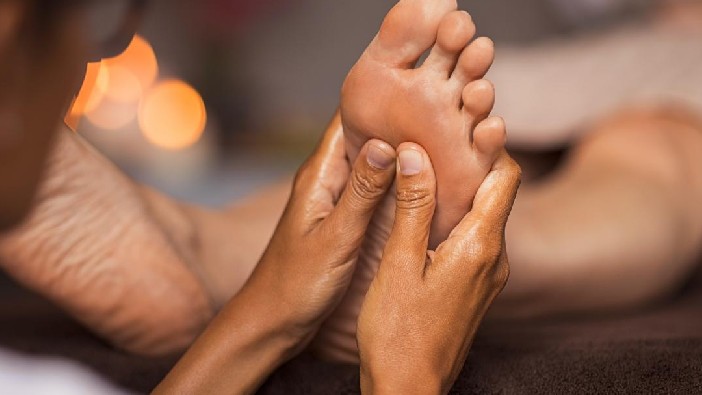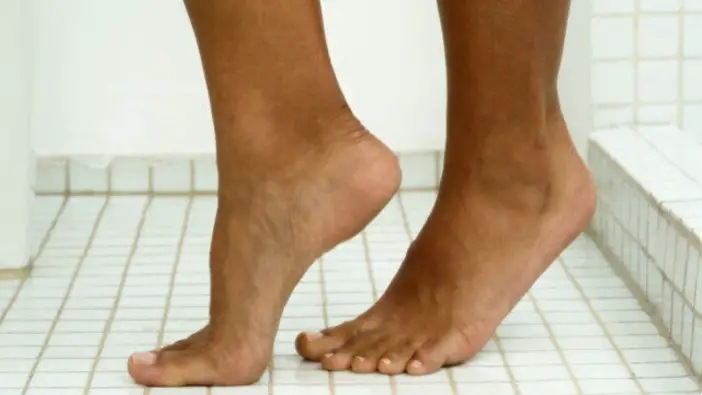Are you experiencing difficulty in moving your feet? Does your heel hurt even when you are not walking? Have you noticed redness or swelling on your heel? If yes, you are experiencing heel pain, and you need to know how to relieve it.
The heel has the largest bone in the body, and several conditions can cause heel pain. Heel pain is common to the foot and ankle; it may be underneath the heel, behind the heel, or within the heel bone itself.
Heel pain can make walking become a struggle and this may affect your daily activities. Such as moving around, exercising, and getting work done.
This article offers easy treatment for heel pain, as well as highlights the symptoms and causes of heel pain.
How to Relieve Heel Pain
Heel pain often does not need surgical treatment to get better. There are home remedies and therapies that focus on relieving pain and inflammation; to improve the flexibility of the feet and also help to minimize strain on the heel.
Here are remedies that will help relieve heel pain.
1. Remedies and Therapies to Relieve Heel Pain
Cold Therapy
Use a bag of ice on the heel to help reduce swelling. Place the ice on the heel for about 10 to 15 minutes. This will reduce inflammation and help numb pain. Do this three to four times daily.
Use Over-the-Counter Pain Relievers
Non-steroidal anti-inflammatory drugs (NSAIDs). These drugs also help reduce pain and inflammation on the heel. Examples of such are ibuprofen and acetaminophen.
Corticosteroid Injections
If the pain doesn’t reduce after using non-steroidal anti-inflammatory drugs, you can opt for these injections. However, you must be conscious of your usage of it. Long-term use of this injection can cause worse effects. This injection will help reduce heel pain and swelling.
Orthotic Devices
Releasing pressure on the heel will help ease pain, and this can be done with custom-made shoe inserts and fillers. Wear supportive shoes that fit properly. Wear heel lifts to reduce heel pain and to support the arch of your foot.
Physical Therapy and Exercises

These exercises will help stretch and strengthen the lower leg muscles. Physical therapy will enable better stabilization of the heel. Do this therapy to relieve pain and reduce inflammation of the heel.
Athletic Taping
You can make use of athletic or medical tape; to support the arch of your heel or foot. Athletic taping reduces inflammation and pain by giving better support to the bottom of the feet.
Night Splints
A night splint is a device that helps stretch the foot as you sleep. Wear a night splint to ease or relieve heel pain. Night splints may be worn around the calf and foot during sleep.
Extracorporeal Shock Wave Therapy
This therapy should only be done for long-term causes that weren’t resolved by conservative therapy. Extracorporeal Shock wave therapy aims for sound waves at the affected area to help stimulate healing.
SEE: Lose Weight With These 15 Simple Exercises
2. Exercises to Relieve Heel Pain
Exercises that stretch the calf’s muscles will help in reducing heel pain and make the foot feel better.
Foot Massage

When you do this exercise and show that you do not experience any pain. Do not apply too much force, only apply enough pressure to make you feel a stretch.
How to do it:
- Sit on a chair or stand on your feet.
- Place one foot on a frozen water bottle.
- Roll the water bottle back and forth under your feet.
- Do this ten times for each foot.
The ice in this water bottle will reduce inflammation in the heel and also relieve heel pain.
Heel Raise
This exercise is to be done slowly and try to control your movements; maintain your balance and hold on to something for support.
How to do it:
- Stand with the balls of your feet at the edge of a stair.
- Slowly lower your heels down slightly below the edge of the stair.
- Ensure that you feel a stretch as you do this.
- Hold the position for a few seconds.
- Now rise on the balls of your feet again.
- Repeat the process 10times.
- Rest your feet
Ankle Inversion
You will need a resistance band for this exercise.
How to do it:
- Sit upright on the floor and keep your legs straight out in front of you.
- Secure a resistance band around your upper foot, and wrap it around the bottom of your lower foot.
- Place your left leg over your right leg.
- Hold the end of the band and move your upper foot (that is, the foot with the resistance band) slowly away from the lower foot.
- Draw your ankle in and slowly return it to the start position.
- Repeat the process 10 times for each foot.
However, ensure that you avoid hips movement during this exercise.
Seated Foot Stretch
Do this exercise in a slow and controlled manner.
How to do it:
- Sit on a chair and cross one leg over the other knee.
- Hold your toes with one hand and use the other hand to hold your ankle.
- Gently pull your toes backward till you feel a stretch at the lower part of your foot.
- Hold this position for about 30 seconds
- Release your toes and switch to the other foot.
- Repeat this process three times on each foot.
Tennis Ball Foot Roll
To do this exercise, you will need a tennis ball.
How to do it:
- Be seated on a chair
- Place a tennis ball under your foot
- Use your foot to roll the ball back and forth.
- Do this for fifteen minutes
- Switch foot and repeat the process.
3. Use Essential Oils
Some essential oils contain properties that help relieve heel pain. Below are a few of these oils.
Lavender oil
Lavender oil contains beta-caryophyllene; an anti-inflammatory property that helps in treating painful inflammation. You can use this oil to relieve heel pain by mixing a few drops of it with coconut oil and massage it gently on your foot or heel.
Rosemary oil
Rosemary oil contains pain-relieving properties such as carnosic acid and rosmarinic acid. To use this oil to relieve heel pain, mix it with coconut oil and gently massage it into your feet.
Eucalyptus oil
This oil also contains properties that help to subdue the pain. Dilute this oil with a carrier oil and massage it into your foot to ease heel pain.
Flaxseed oil
Flaxseed oil alpha-linolenic acid helps to cure inflammation and relieve pain. You can use this oil to relieve your heel pain. Heat the oil and massage it on your skin and leave it on for about an hour.
SEE: Experiencing Hair Loss? Learn 12 Possible Reasons Why and How to Treat It
4. Surgical Treatment for Heel Pain
Listed before now are easy ways to relieve heel pain, but if nothing works to relieve the heel pain, then a surgeon needs to operate on the heel. However, there is a huge risk of weakening the arch of the foot.
How heel pain is diagnosed
A doctor will carry out a physical examination on your feet, ask about the pain and then test the muscles of the leg to look out for unusual shape changes.
The presence of nerve problems or a stress fracture can be detected easily by squeezing the knee. However, an x-ray will be done to check for arthritis, bone fractures, or alignment and joint damage, after which treatment will commence.
When to see a doctor
You may not need to call the doctor immediately if you develop heel pain. Try some home remedies first to help relieve the pain, you should feel better within 2-3weeks after using painkillers.
If after trying the remedies, the pain persists, then you should make an appointment with the doctor.
Contact your doctor immediately if:
- You are unable to work due to the pain.
- Your feet/heel starts to swell.
- You experience severe inflammation or stiffness in your foot.
- There is redness in your heel.
- The pain starts suddenly and is severe.
- Bending or standing on tiptoe becomes difficult.
- You feel feverish, and your heel feels numb.
- Pain persists when you are not moving or standing with your feet.
Symptoms of Heel Pain
Heel pain symptoms vary. The cause of the pain will determine what symptoms one gets. You may experience the following symptoms:
- The bony growth on the heel
- Redness on the heel
- Stiffness of the heel
- Tenderness
- Pain after standing from a resting position.
- Pain while resting
Causes of Heel Pain

Heel pain can be caused by anything that puts a lot of pressure on your foot. You will most likely develop heel pain if you:
- Are overweight
- Run a lot
- Stand on hard or concrete floors for a long time
- Wear shoes that do not support the arch of your heel.
- Wear shoes that do not fit your heal properly.
There are several other causes, such as;
1. Plantar Fasciitis
This happens when the Plantar fascia muscle is stretched too far; it causes soft tissue fibers to become inflamed.
When this happens, pain is felt under the feet after long periods of rest. Too much pressure on your feet can cause this.
2. Heel Bursitis
Bursae are sacs filled with fluid; usually found in the joint. Inflammation can occur on it when the feet land hard on the heels and when there is pressure from the footwear.
The heel pain that happens as a result of this may be felt deep inside the heel or at the back of the heel. Sometimes, swelling may occur on the Achilles tendon. If this, however, is not treated immediately; the pain will get worse as the day progresses.
3. Heel Bumps
Heel bumps are common in teenagers. The heel bone of teenagers are not fully mature, and involvement in too many activities can result in the formation of too much bone in the heel.
This condition, also known as pump bumps, is often caused by having a flat foot. It can also be caused by wearing high heels on an immature bone.
4. Neuroma
This happens when a nerve becomes swollen in the ball of the foot. It is also referred to as Morton’s neuroma.
5. Achilles Tendonitis
Achilles tendonitis, also known as tendinopathy and tendinosis, is a condition that occurs due to the breakdown of the Achilles tendon. When there are multiple tears on the tendon, the Achilles tendon tends to malfunction.
The tendon, due to this, becomes weak, thick, and painful. This condition requires quick medical attention to avoid further damages.
6. Stress Fracture
This happens due to repeated stress, strenuous exercise, and sports, or heavy manual work. Athletes such as runners are prone to stress fractures in the bone of the foot; this then causes heel pain.
7. Sprains and Strains on the Foot
Strains on the foot often occur as a result of injuries that happen during stressful physical activities.
FAQ on How to Relieve Heel Pain
How can I get rid of heel pain at home?
You can get rid of heel pain in the comfort of your home by trying out the home remedies stated in this article. The easiest remedies are; cold therapy, foot massage, and calf stretches.
How do I stop heel pain at night?
You can make heel pain go away at night by drinking enough water during the day.
This will help keep your body hydrated and relieve muscle cramps.
How long does it take to get rid of heel pain?
Heel Pain can take weeks to heal; depending on the cause of the pain.
If the cause has to do with the heel bone; recovery will take a longer time.
Conclusion
Heel Pain, although it may not be a cause for alarm, can affect your lifestyle. It causes an inability to move from one place to another; it also stops you from engaging in fun activities.
Recovery from heel pain takes time, depending on the cause; give your body enough time to rest. Don’t be in a hurry to resume activities that will again stress your feet and hinder your recovery.
Thanks for reading.
Africana Fashion provides you with relevant health and wellness articles for tips and solutions.






